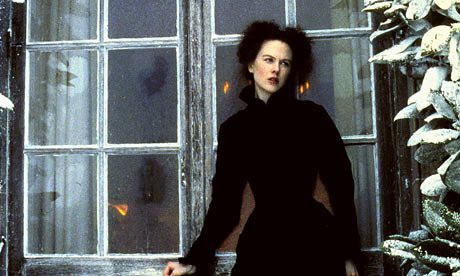Parenting by the Books: The Portrait of a Lady
Miscarriage and Isabel Archer’s absent baby.

To paraphrase Emily Dickinson, miscarriage has an element of blank. It’s a form of emptiness, of possibility blinking out in front of you. Sometimes it’s a relief, but often it’s the maddening feeling of losing something you never had in the first place. The feeling is exacerbated when you look up and realize you are literally surrounded by women who have also experienced this very common form of loss. How had you missed them? Why didn’t you know about one another? We seem to diagnose the problem — the personal and communal invisibility of miscarriage — as stemming from women not talking about it enough (because shame, because misogyny, because whatever). The solution then is somewhat simple: tell your stories, share them with strangers and intimates alike.
In this kind of account, miscarriage emerges as a subject about which we could accrue knowledge. Maybe if we make the cultural curriculum on women’s reproductive lives more rigorous, and ensure that we’re all more deeply knowledgeable, we could ace the test. “One in five pregnancies ends in miscarriage, here are their stories.” Nobody would have an excuse to say “I didn’t know / it was so common / no one ever talks about it.” But then again, one in five high school students has read Romeo and Juliet, and we still don’t actually know shit about love. Understanding requires stories and information, but stories and information don’t automatically produce understanding. Simply having the language doesn’t always solve the problem. We’ve got an interpretive problem when it comes to reproduction.
Take, for example, Isabel Archer’s baby in Henry James’s The Portrait of a Lady. You’d be forgiven for not having devoted even two minutes to thinking about Isabel Archer’s strangely absent baby in this beloved/hated novel, because his short life exists in a literal blank, in James’s famous literary version of a dissolve between Chapters 35 and 36. A flash forward. A refusal to narrate.
At the end of Chapter 35, Isabel Archer makes the disastrous decision to marry the emotional (and financial) vampire Gilbert Osmond, and the book promptly abandons her there. James doesn’t narrate their wedding or the first few years of their marriage; Chapter 36 opens on a scene three years later, told through the point of view of the minor male character Ned Rosier. The reader is exiled from the inner life of a young woman they’ve come to care about deeply over the course of the novel’s first three hundred pages.
I’d probably read the novel five or seven times before I really noticed that she’d had a baby and that he’d died. As a literature professor, I could explain this narrative feature through various interpretive modes: a little (taboo, but still so tempting!) authorial biography here, a little formalism there, a good dose of feminist literary theory, and probably a mini-lecture containing historical context about childhood mortality rates in the nineteenth century. But of course it doesn’t escape me that I didn’t notice the loss of her child until a reread between my first and second miscarriages.
It’s not entirely surprising that I missed this important narrative detail because it is only mentioned twice, very much in passing. The first mention comes in a conversation between Madame Merle (the frenemy who has orchestrated the emotional tragedy of Isabel’s marriage to Osmond) and Ned Rosier:
“Mrs. Osmond,” Madame Merle went on, “will probably prefer to keep her money for her own children.”
“Her own children? Surely she has none.”
“She may have yet. She had a poor little boy, who died two years ago, six months after his birth. Others therefore may come.”
“I hope they will, if it will make her happy. She’s a splendid woman.”

Later, Isabel’s beloved and dying cousin Ralph will note how much she’s changed since her marriage to the soul-sucking (let’s be real, he’s the anti-Christ) Osmond: “There was something fixed and mechanical in the serenity painted upon [her face]; this was not an expression, Ralph said — it was a representation. She had lost her child; that was a sorrow, but it was a sorrow she scarcely spoke of; there was more to say about it than she could say to Ralph.”
And that’s all we hear about Isabel Archer’s baby.

Part of me wishes Isabel could have found some words to speak directly about her sorrow to us. James himself, and most literary critics, make a big to-do about Isabel’s Chapter 42 “fireside vigil” in which she reflects on how she has been made use of for her money, and which takes place entirely in her consciousness (an innovative narrative feature in 1881). Much of The Portrait of a Lady’s aesthetic achievement is in how direct our access to the heroine’s interior life is, and how clearly she eventually comes to see her own situation.
But a bigger part of me recognizes that speaking more will not entirely solve our reading problem when it comes to the blanks that characterize our understanding of the physical and emotional realms of reproduction. I feel protective of Isabel’s unspoken sorrow. To require, or even ask for, testimony on her part as to what the loss of her child felt like, feels cruel. Why not, instead, become better readers ourselves?
After my first miscarriage, I sat for weeks, stunned, on the couch, hand-mending an old ratty comforter that we’ve never been able to bring ourselves to throw out. The fabric on this comforter is so worn and soft and perfect, the type of fabric that one of my nieces in toddlerhood used to call “gooey.” I barely know how to sew, and the edges of the fabric practically dissolved as I pushed the needle in and out, trying to put back together something that refused to hold its shape.
As for the second, I honestly don’t remember much. It felt fated. I remember the look of a book propped up on my knees as I laid on the couch, but I don’t remember the look of the doctor who told me the pregnancy was no longer viable. I read The Hunger Games trilogy in between finding out and having a D&C. I can’t immediately call to mind the procedure itself, what the room was like, how I got to the hospital, how I got home, the days after. If I were a character in a novel, it would feel right for these scenes to remain unnarrated.
Isabel doesn’t tell us what it felt like to lose her baby, but she does, at the end of the novel, spend time mending her stepdaughter Pansy’s dress — her “desecrated drapery” — at a ball. I read this scene differently after trying to mend my own way through reproductive loss. Isabel’s hands mending that skirt tell us about care, women’s reproductive labor, and loss as embodied and irreducible: incapable of being explained in language. Sometimes it seems like the contemporary idea is that if we share more — more stories, more language, more information — about women’s reproductive realities, we’ll finally understand it, that it will finally become clear, comprehensible, and coherent. I just don’t know if this is true.
Isabel Archer is one of my intimates, but my knowledge of her has always been in progress. When we first meet her, she is striding across a wide open lawn, and stoops down to scoop up a sweet and wriggling dog, Bunchie, who has run up to greet her. When we later rejoin her after her marriage, after the loss of her child, she is swathed in black velvet: “her light step drew a mass of drapery behind it.”
We adopted a dog right before finding out I would need infertility treatments, and he accompanied me through three years of injections, miscarriages, and loss. I loved him so much. Three days before an IVF embryo transfer, he was killed when he got away from his dog walker and ran into the street. There is more to say about this than I can really say. My miscarriages, my sweet dog, and the children I now have are woven into a fabric that only just holds it shape. Do you need to know more than that?
“Parenting by the Books” is a series about parenting and classic literary texts.
Sarah Blackwood is editor and co-founder of Avidly and associate professor of English at Pace University.